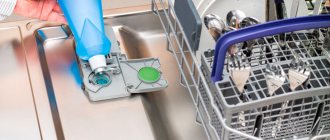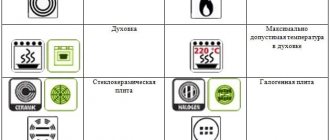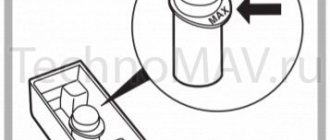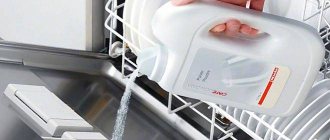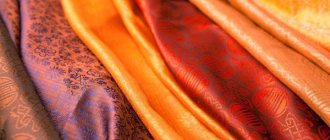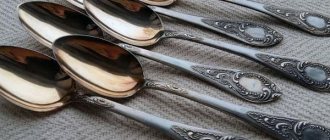Have you ever wondered whether pots can be washed in the dishwasher? It all depends on the dimensions and materials of the dishes, on the parameters of the PMM.
Do not place, for example, aluminum or wooden utensils in the dishwasher. What is the situation with pans - stainless steel, ceramic and Teflon coated? If you want to know the details, read our article.
How to properly wash a pan in a PMM?
- Before loading into the dishwasher, remove any leftover food and rinse under running hot water.
- Make sure it is made from a material that can be washed in a detergent.
- Place it on the lower basket. Installation method: upside down. It is important that large dishes do not interfere with the operation of the dishwasher.
- Use intensive mode.
Rule #5 – Take care of your dishwasher
Any technique loves care. Dishwashers are no exception. If you want your machine to serve you for a long time, follow these recommendations.
Clean the filter from time to time (washed-out food residues settle on it). Also wash the dish baskets regularly (they are usually easy to remove).
Use additional dishwasher care products. So, every 15-20 cycles it is recommended to use a degreaser (powder or gel product). It helps remove accumulated grease from the inside of the machine.
Also, give your car “prevention” 2-4 times a year. To do this, you can use a special product or regular citric acid. Pour anti-scale into the dispenser and turn on the unloaded machine on a standard cycle.
Finally, at least once a week, wipe the dishwasher with a damp cloth, inside and out, not forgetting the door seal.
What can be loaded into the PMM?
If a dishwasher only washed plates and cups, she would be worthless. Housewives need more serious help - they need to wash pots and pans. But before loading dirty dishes into the PMM chamber, you need to find out what they are made of. Not every material is suitable for water procedures in the dishwasher hopper. What you need to know about materials and coatings:
- Products with ceramic coating can be loaded into the chamber. Both a full cycle and an express mode are suitable for them.
- Titanium coating. Such dishes are washed with gentle means, setting a low temperature.
- Stainless steel. Stainless steel cookware has a thin non-stick layer - due to powerful processing, it will gradually wear out and food will stick to the surface.
- Aluminum. It is allowed to load aluminum products only if they have a durable coating, otherwise they will darken.
- Glass. They are allowed to wash in the PMM, but with the condition - not to hit neighboring objects.
- Gilded drawing. Processes in the dishwasher will cause the drawings to fade and then be completely erased.
Rule No. 4 – watch the water hardness
The cleanliness of dishes washed in the dishwasher also depends on the hardness of the water. Hard water leaves white streaks on dishes.
In most cases, water softening is required for the machine to function properly. For this, regenerating salt is used. Usually the capacity for it in cars is quite large - 1-2 kg. It lasts long enough.
In addition, lime from hard water settles on the heating elements of the machine, which can cause damage. Therefore, salt is also necessary to protect the device.
How is washing done?
Knowing how a dishwasher works, it is easier to understand what items can be washed in it. Process steps:
- Start the program. Water begins to flow into the chamber - cold or hot.
- Maximum water heating is 70 °C.
- The detergent comes from the dispenser - powder, gel or soluble tablet.
- Water collected in the tank enters the sprinklers, which, rotating, wash objects.
- Water circulation continues for the time specified by the program.
- When the main process is over, the dirty water goes into the sewer. Clean water enters the tank and rinsing begins.
- Recent PMMs provide gentle cycles that operate at low water temperatures - they are used for lightly soiled dishes.
It is clear that with this approach, it will not be possible to wash off severe stains - old, with soot - even in a few hours. It is unlikely that you can wash a dirty pan in which stew or porridge has burnt in the dishwasher - you need to work with a mesh or brush using abrasive chemicals.
If the kettle smells like plastic, clean it with lemon
First of all, you need to thoroughly boil the water in the new kettle; it must certainly be filled with water to the very top. Fifty grams of citric acid should be added to the water. There is a more expensive, but also more effective way: squeeze the juice from three lemons. After this, you need to boil water in a kettle with this juice and then just leave the water like that without pouring it out overnight. In the morning, pour out this water, pour in new water, then boil, then thoroughly wash the kettle. In the evening you can repeat this process again. Lemon juice will even help remove bad odors from the refrigerator - we already wrote about this.
When a new kettle smells like plastic and you need to eliminate this unpleasant odor, you can also use just lemon peels; this is also quite effective, but a more budget-friendly method than lemon juice. To do this, fill the kettle approximately halfway with regular lemon peels, and fill the water to the top. First you just need to boil the kettle, and after boiling you need to leave the kettle with water, with all the peels, lemon peels, overnight. In the morning, you need to boil this kettle with water again, then drain the water and thoroughly rinse the inside of the kettle under running water. You can cleanse with lemon juice one day, and use the lemon juice the next day. This is rational and will give a good result.
If suddenly, for some reason, you don’t have any lemons, or their peels, or even citric acid on hand, then you can completely use the essence of vinegar, or even simple table vinegar. You should add 100 grams of simple table vinegar or 40 grams of vinegar essence to your kettle and then fill it with water to the very top. After this, the kettle must be heated, but in a situation with vinegar it cannot be boiled, just as when using vinegar, a natural reaction must occur when water boils, and then the water will be spilled through the top of the vessel. This simple operation should be done several times in a row, and only after you have already poured out the water, rinse your kettle thoroughly.
Dishwasher characteristics
The ability to wash the pan depends on:
- Dimensions of the device. Large dishes may not fit in the dishwasher hopper. If you have a compact model, you can only wash a 2-liter container. You won’t be able to fit saucepans that are too bulky into the narrow model either. If you want to wash large utensils, buy a full-size PMM.
- Functionality. If your machine does not have an intensive wash mode, then washing dirty pots is like light rain. It is advisable that the programs include soaking - with it the washing process will be more successful. Perhaps your model has a special program for pots. To find out, read the instructions.
- Washing class. Dishwashers are graded according to their washing class. Today you won’t see C- and D-class devices. Only class A and B equipment are available for sale. Class A machines are capable of washing the most difficult stains, plaque and congealed grease.
- Drying systems. Condensation drying is more common. How does it work? The products are heated and moisture is removed from their surface. This is an economical method but takes a long time. There are fewer models with turbo drying on sale. It allows you to dry plates faster, as air is used. This process requires energy. This is a less economical option. Users of PMMs with condensation drying often complain that moisture remains on the dried dishes.
Product comparison: choosing which model to choose and buy
| Product photo | Product Name | Rating / Average price |
| Casserole Rondell Flamme 2.3 l | 2999 rub. | |
| Casserole Rondell Flamme 3.2 l | 3255 rub. | |
| Appetite Rondy casserole 3.9 l | 906 rub. | |
| Saucepan Attribute Classic 1.4 l | 660 rub. | |
| Casserole Rondell Flamme 5.7 l | 3790 rub. | |
| Appetite Roses casserole 4 l | 547 rub. | |
| Casserole Appetite Roses 5.5 l | 644 rub. | |
| Saucepan Attribute Augusta 3 l | 900 rub. | |
| Attribute Lime saucepan 3 l | 1310 rub. | |
| Saucepan Attribute Augusta 2 l | 790 rub. |
What to wash with?
The products you used to manually wash kitchen utensils cannot be used in the dishwasher. The stores have special washing products for PMM. Release form: powder, gel or tablet. The latter is a compressed briquette, which, in addition to detergent, may contain salt, rinse aid, and other useful substances with different effects. Features of application:
- Powders, gels and simple tablets require the parallel use of salt and rinse aid.
- Universal tablets - "three in one" - do not need any additions. They contain everything you need for washing.
Choose products that contain enzymes. These substances, by breaking down organic compounds, remove complex contaminants and improve the quality of washing.
Why does a new kettle smell like plastic?
There are several main reasons why a newly purchased electric kettle may emit a very strong and unpleasant aroma.
The new kettle smells:
- Due to residues of special technical oil that was used during the production of the device and was not completely removed after the completion of the manufacturing process. In most cases, this problem can be solved by boiling water three times in a new device, which should help get rid of the unpleasant aroma;
- Due to the smell of chemicals and plastic that got into the hermetically sealed bag with the device at the manufacturer. This situation can also be solved without using any improvised methods. It is enough just to boil the new device with plain water, and then leave it to air for 3 days (preferably in a well-ventilated area). This method allows you to get rid of the stench forever;
- Because of the plasticizer, which is used to create all plastic parts of electrical appliances. Its main function is to extend the service life of the product, but it is very harmful to human health. If this smell cannot be removed by boiling and airing, then it is better not to use such a device, but to buy a new one of high quality;
- Due to the use of cheap dye. If the smell of this dye also cannot be eliminated by boiling, then you should stop using the device.
The first two reasons are quite harmless and easy to get rid of. The second two are very significant and the use of a new device that has an unpleasant odor of this nature is strictly not recommended. In this case, the new kettle should be returned to the store and demand replacement with another device or a refund of the money paid for the product.
Other cleansing methods
A more “civilized” way to combat the nasty smell from plastic is to use specialized detergents. These products usually include various alkaline solutions with water, but they contain surface-active components.
Immediately after using such products, it is recommended to rinse your kettle thoroughly, preferably under running water. This must be done, since surfactants and other additives in household chemicals can cause significant harm to your health. In general, people all over the world are now trying to live a simple, eco-friendly lifestyle and use natural cleaning methods with vinegar, soda, lemon and citric acid.



